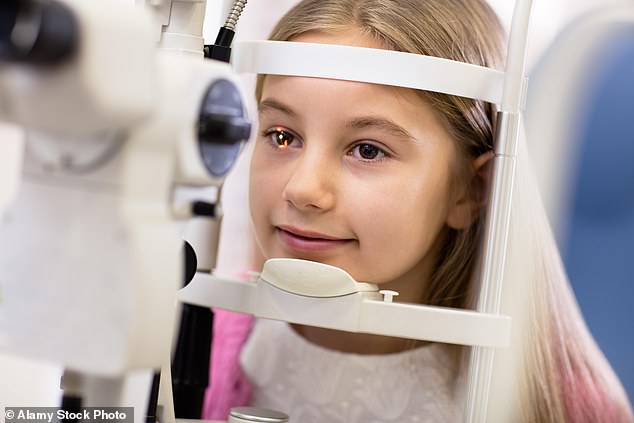Lockdown may have left thousands of British children with damaged eyesight, according to new research.
While the stay-at-home orders helped to cut the covid infection rate, one of the unintended consequences appears to have been a detrimental impact on the eye health of the UK’s kids.
The gigantic uptick in screen time and a lack of natural light led to what some specialists called ‘coronavision’.
A March 2024 study in the British Journal of Ophthalmology found that short-sightedness – known medically as ‘myopia’ – triped globally between 1990 and 2023.
Scientists detected a ‘notable’ jump after the covid pandemic. Whereas between 1990 and 2019, global rates of myopia increased by 5.34 per cent, in the period from 2020 – when the pandemic hit – to 2023, that number shot up to a 6.15 per cent rise.
Now new research on children in the UK appears to corroborate those findings.
More than 1,000 pre-school youngsters in Scotland were diagnosed with short-sightedness in the wake of pandemic emergency measures – a 42 per cent rise in the incidence of myopia.
The alarming figures, unveiled at an international conference, suggest that a lack of natural light while spending more time indoors due to pandemic restrictions may have left many children unable to see properly.

More than 1,000 pre-school youngsters were diagnosed with short-sightedness in the wake of pandemic emergency measures – a 42 per cent rise in the incidence of myopia

Increased amounts of screen time, lack of natural light and activity during COVID-19 pandemic had a catastrophic effect on their eye health, according to several studies

Eye experts say kids can prevent myopia by spending more time outside, taking breaks between looking at the screen, and even blinking more
It’s the latest study that lays bare the scale and range of harm inflicted on young Scots by lockdown.
Social work consultant Maggie Mellon – former director of services for the charity Children 1st – said: ‘Locking down children, closing schools and denying them fresh air and exercise was one of the worst decisions made.
‘If there is a lesson from lockdown, it is to cut screen time, get children out of doors as much as possible, and ensure that every family has sufficient income and access to resources to give their children the good start in life that they need.’
All children aged three to five are offered eye tests under the NHS’s See4School programme.
Researchers from Ninewells Hospital in Dundee and London University analysed the results from eight Scottish health boards for three years before the pandemic – 2013/14 to 2015/2016.
Then they compared them with post-lockdown figures for 2020/21 and 2021/22.
Diagnoses of myopia rose significantly from an average of 405 per year before the pandemic to 579 afterwards. In 2013/14, there were 320 cases, in 2021/22 there were 586.
It’s unusual for myopia to set in at a very young age, which makes the latest results all the more concerning.
But the true scale of the damage is likely to be far greater as only pre-schoolers are routinely tested in Scotland.
In the Chinese city of Feicheng – where families were subject to a brutally-strict lockdown be-tween January and May 2020 – experts examined the eyes of children aged six to 13 returning to primary and secondary classes.
They uncovered an epidemic of what they called ‘quarantine myopia’.
Short-sightedness was detected in 22 per cent of six-year-olds – a staggering fivefold jump compared with before Covid.

A lack of natural light while spending more time indoors due to pandemic restrictions may have left many children unable to see properly

Between 1990 and 2019, global rates of myopia increased by 5.34 per cent, in the period from 2020 – when the pandemic hit – to 2023, that number shot up to a 6.15 per cent rise

Diagnoses of myopia among pre-school children in Scotland rose significantly from an average of 405 per year before the pandemic to 579 afterwards. In 2013/14, there were 320 cases, in 2021/22 there were 586
The latest Scottish study has found echoes of a similar crisis – and calls for an expanded testing programme to shine a light on the true scale of the problem.
The report, which is still undergoing peer review, states: ‘Even at this young age, approximately one in ten children in the post-pandemic dataset who fail vision screening analysed here is myopic.
‘This raises concerns about the need to repeat vision screening periodically during the school years.’
The research team – which reported its findings to the recent European Association for Vision & Eye Research Congress in Valencia, Spain – also found a link between short-sightedness and urban areas with larger numbers of flats.
Children in Greater Glasgow & Clyde and Lothian health boards were twice as likely to be myopic as those in Highland or Ayrshire & Arran.
Professor Bruce Evans – who led the study – said the statistics couldn’t prove conclusively that lockdown is to blame.
But he added: ‘There is considerable evidence suggesting that increased time outdoors is protective against developing myopia.
‘Likely reasons for this include increased light levels and possibly a broader spectrum of light, finer detail in visual scenes and more distance vision.

‘It seems likely that, during the pandemic, [the tested] children probably spent more time at home and less time outdoors than usual.
‘Conventional spectacles correct myopia, which is very important because this allows the child to see the white board in class clearly. However, conventional spectacles do not have a signifi-cant effect on myopia progression.
‘Practitioners are concerned about more children becoming short-sighted at younger ages be-cause, on average, they are likely to end up with higher [serious] myopia.
‘Myopia increases the risk of eye diseases in later life, and the higher the myopia the greater the risk.’








